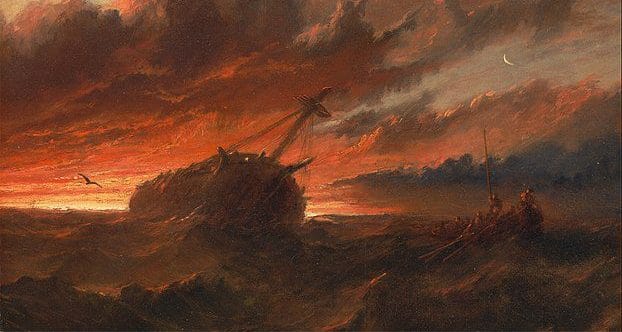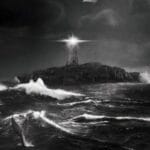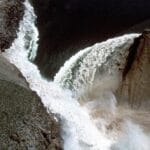The Titanic’s tragic sinking is a story known worldwide, a benchmark for maritime disasters. But history’s waters hold tales of other shipwrecks, some even more harrowing, involving greater loss of life, unimaginable horror, or scandalous neglect. These forgotten nightmares reveal the raw power of the sea and the extremes of human behavior in the face of death. Prepare to discover ten such maritime tragedies that often eclipse even the Titanic in their sheer terror and enduring impact.
10. SS Arctic, 1854
We often hear the phrase “women and children first,” a noble principle ideally followed during maritime disasters. But what happens when this code is utterly abandoned? This was the grim reality for the SS Arctic. On September 27, 1854, this passenger steamship, operated by the Collins Line, found itself in a dense fog off Newfoundland and collided with the French fishing vessel, the Vesta. Efforts to plug the gaping hole with sailcloth and mattresses proved futile. Over four agonizing hours, the relentless sea crept in, eventually silencing the ship’s boilers and, critically, its life-saving pumps.
The Arctic carried 250 passengers and 150 crew, yet its six lifeboats could only hold about 180 people. Initially, the loading of women and children proceeded as expected. However, panic soon erupted among the ship’s crew. Discipline shattered. A chaotic scramble ensued, with mobs of men overrunning one lifeboat after another. One overloaded boat capsized, plunging its occupants, mostly women, into the icy waters to drown. The captain, desperately trying to restore order, attempted to launch another boat on the ship’s opposite side. Tragically, it too was commandeered by male crew members instead of the women and children awaiting rescue.
The final two lifeboats, along with a makeshift raft constructed by loyal officers, were also taken by crew members. One boat was brazenly stolen by engineering staff who, brandishing firearms, deceitfully claimed they needed it to patch the ship’s hull. Once launched (only half-full), they rowed away swiftly, abandoning the waiting women and children to their doom. Of the 400 souls aboard, a mere 85 survived: 61 crew members and 24 male passengers. Every single woman and child perished in the disaster.
9. SS Pacific, 1856
The sinking of the SS Arctic was a devastating blow for Edward Collins, founder of the Collins Line, who lost his wife and two children in that tragedy. Barely two years later, fate dealt him another cruel hand. The Arctic’s sister ship, the SS Pacific, vanished without a trace in the vast Atlantic in January 1856. The ship had departed Liverpool bound for New York City, carrying 45 passengers and 141 crew members. After it sailed, no definitive word of its fate ever reached shore.
The only clue, if authentic, came five years later, in 1861, when a message in a bottle reportedly washed up on the coast of the Hebrides islands. The chilling note offered a possible explanation for the Pacific’s disappearance: “On board the Pacific, from L’pool to N. York. Ship going down. Great confusion on board—icebergs all around us on every side. I know I cannot escape. I write the cause of our loss that friends may not live in suspense. The finder of this will please get it published.” Whether this message was a genuine final communication or a cruel hoax, the SS Pacific and all aboard were swallowed by the ocean, leaving behind only questions and sorrow.
8. Empress of Ireland, 1914
Following the Titanic disaster, maritime safety regulations were updated, and the ocean liner RMS Empress of Ireland, part of the Canadian Pacific Steamship Company, was among the vessels to benefit. It boasted watertight doors and enough lifeboats for 280 more people than its maximum capacity. Yet, these precautions proved insufficient when, on the night of May 29, 1914, it collided with the Norwegian collier Storstad in a dense fog at the mouth of the Saint Lawrence River. The great ship sank in a mere 15 minutes, claiming 1,012 of the 1,477 people on board.
Water flooded into the Empress of Ireland so rapidly that there was no time to close the watertight doors. The ship listed sharply to starboard, rendering the port side lifeboats unusable as they couldn’t be lowered. Many passengers sleeping on the starboard side drowned in their cabins. Some who managed to reach the boat deck successfully launched five lifeboats from the starboard side.
About five minutes after the collision, the ship’s power failed, plunging everything into terrifying darkness. Five minutes later, with all usable lifeboats gone, the Empress of Ireland rolled onto its starboard side. This grim turn allowed hundreds of desperate passengers to clamber onto the exposed port side hull. There, they sat for a few agonizing minutes, watching the frigid water slowly rise to claim them. One survivor described the horrifying scene as being “like sitting on a beach watching the tide come in.”
7. Essex, 1820
While the death toll of the whaling ship Essex doesn’t compare to that of the Titanic or others on this list, its story surpasses them all in sheer, unadulterated horror. This vessel was the real-world inspiration for Herman Melville’s epic novel, Moby-Dick. In November 1820, about 2,000 miles west of the South American coast, an enraged sperm whale rammed the Essex not once, but twice. The twenty-man crew had no choice but to abandon their sinking ship, taking to three small whaleboats with whatever meager food and water supplies they could salvage. Their desperate goal was to reach South America.
Within two weeks, their food ran out. Water became so scarce they were forced to drink their own urine. A temporary reprieve came when they landed on barren Henderson Island, where they foraged for food and water. But after exhausting the island’s resources, they set sail again in their vulnerable boats, leaving behind three men who chose to stay. By January, the grim reality of starvation set in, and men began to die. The first two bodies were committed to the sea. However, when a third man died, their hunger was so extreme that the survivors made the horrifying decision to resort to cannibalism. As more men succumbed, they too were consumed.
Soon, even this gruesome source of sustenance wasn’t enough. The remaining men drew lots to decide who would be sacrificed to feed the others. A young man of 18, Owen Coffin, drew the black spot. He was shot and butchered by his crewmates. One of them died ten days later and was also eaten. It wasn’t until late February 1821, off the coast of Chile, that the five dazed, traumatized survivors were rescued. They had survived by eating no fewer than seven of their comrades.
6. Sultana, 1865
Imagine this: you’ve endured years in Andersonville, the infamous Confederate prison where starvation, disease, and brutal treatment killed around 13,000 of your fellow soldiers – a staggering 29% death rate. The Civil War, after four long, bloody years, has finally ended. You’ve just been told you’re going home. This was the hope carried by some 1,953 released Union prisoners of war as they were crammed onto the decks of the Sultana. This northbound Mississippi river steamboat was designed to carry only 376 passengers. Along with an additional 177 passengers and crew, the overburdened Sultana slowly navigated a Mississippi river swollen by one of the worst floods in recent memory.
All seemed well until 2 a.m. on April 27, 1865. Suddenly, both of the ship’s faulty boilers exploded under the immense strain. A jet of scalding steam erupted, blowing out the center of the boat, demolishing the pilothouse, and collapsing the smokestacks. Hundreds were trapped in the wreckage, which quickly caught fire. Those caught beneath the collapsing decks were either scalded or burned to death. Hundreds of other ex-prisoners, weakened by their captivity, jumped overboard only to drown, unable to stay afloat in the strong currents. When the fiery hulk of the Sultana finally sank near the Arkansas shore around 7 a.m., approximately 1,169 men had died. This catastrophe remains the greatest maritime disaster in U.S. history.
5. SS Central America, 1857
On September 9, 1857, the SS Central America was steaming off the Carolina coast, laden with precious cargo: 477 passengers, 101 crew members, and over nine tons of freshly mined gold from the California Gold Rush. Suddenly, it found itself trapped in the terrifying grip of a hurricane. For two relentless days, the ship battled the storm, its steam-powered paddle wheels valiantly keeping it pointed into winds gusting at 100 mph. But by September 11, the situation grew dire. The boilers began to fail, the sails were shredded to ribbons, and leaks sprang, threatening to overpower the pumps.
When the boilers finally gave out, the engines and pumps fell silent. The ship was adrift, completely at the mercy of the raging storm. Passengers, their eyes red with exhaustion, spent a long, dark night bailing water, passing buckets hand-to-hand through the tilting ship. But it was a losing battle against the encroaching sea. The eye of the hurricane brought a brief, eerie calm, allowing those doomed to momentarily contemplate their fate. When the storm returned with full force, the ship continued its slow descent, sinking by the stern.
As morning light broke, another ship was spotted in the distance. Women and children were quickly loaded into the lifeboats and launched into the perilous, stormy sea. Through these efforts, about 153 people were saved. However, when the SS Central America finally succumbed after its three-day struggle, it took some 425 souls down with it, along with its glittering treasure.
4. SS Princess Alice, 1878
An evening excursion by paddle steamer up the River Thames should have been a delightful experience, and so it was for about 700 Londoners on the evening of September 3, 1878. Their pleasant journey turned into a nightmare when the SS Princess Alice was sliced in two by the oncoming collier SS Bywell Castle in Galleon’s Reach, just east of London. For those below decks at the moment of impact, there was no chance of survival. The broken ship slipped beneath the river’s surface in a mere four minutes.
Despite rescue boats being launched from both the Bywell Castle and nearby riverfront properties and factories, hundreds of people, weighed down by their heavy Victorian clothing, were pulled under by the strong currents. As terrible as this was, what happened next escalated the disaster into an unimaginable horror. The pumping stations for London’s sewer system discharged raw sewage directly into the Thames at the very spot where the Princess Alice sank. Just an hour before the collision, over 90 million gallons of untreated sewage had been dumped into waters already polluted by local gas works and chemical factories.
The Times quoted a local chemist who described the outflow as “two continuous columns of decomposed fermenting sewage, hissing like soda-water with baneful gases, so black that the water is stained for miles and discharging a corrupt charnel-house odour.” This toxic sludge proved fatal even to those who didn’t drown in it. Of the 130 survivors of the initial disaster, approximately 16 later died from illnesses contracted after ingesting the putrid, chemical-laden water.
3. SS Atlantic, 1873
Before the infamous loss of the Titanic in 1912, the White Star Line’s most significant catastrophe was the sinking of the SS Atlantic. This tragedy occurred on a different April night, 39 years earlier. The Atlantic was en route from Liverpool to New York with 952 passengers and crew. Concerns about coal supplies led to a decision to divert to Halifax, Nova Scotia, to refuel. While approaching what they believed to be the harbor entrance during a ferocious storm, the ship was dangerously off-course by over 12 miles, heading directly for submerged rocks.
The helmsman, failing to spot a familiar lighthouse west of the harbor, voiced his concerns to the officer on the bridge, only to be curtly told to maintain course. When the ship inevitably struck the hidden rocks, its hull was violently smashed inward. Passengers clung desperately to the listing vessel, watching in horror as one after another of the 10 lifeboats were launched, only to be crushed against the ship’s hull or swept away by the raging sea. With no other escape route from the rapidly capsizing ship, a brave crewman named John Speakman swam to nearby rocks trailing a rope. He established a lifeline, enabling the strongest survivors to pull themselves to shore.
Through this heroic act, some 429 passengers and crew managed to survive. They were forced to watch helplessly as the remaining 535 people drowned. This included all 156 women and 188 of the 189 children aboard the ship. The loss of the Atlantic, commemorated in artworks by Winslow Homer and Currier & Ives, was the deadliest civilian maritime disaster of its era, a grim title it held for 25 years.
2. SS La Bourgogne, 1898
Speeding through a dense fog bank southeast of Halifax, Nova Scotia, in the pre-dawn hours of July 4, 1898, the SS La Bourgogne met its doom. This French ocean liner, journeying from Le Havre to New York, was struck amidships by the iron-hulled sailing vessel Cromartyshire. For passengers sleeping on the starboard side, escape was nearly impossible as their compartments rapidly filled with water. Others woke to the terrifying realization of their impending fate.
The collision damaged or destroyed the starboard side lifeboats. When the crew attempted to launch the port side boats, their efforts were hampered by the increasing list to starboard, which caused the port side to roll upwards, making boat deployment extremely difficult. As discipline completely collapsed, passengers and crew fought viciously for a place in the few undamaged lifeboats. Within a harrowing 30 minutes, the great ship settled and then slipped beneath the waves, stern first.
It was only when the sun rose and the fog finally lifted that the crew of the Cromartyshire (which remained afloat) realized the catastrophic extent of the damage to La Bourgogne and began rescue efforts. But by then, it was tragically too late for most. Of the 726 souls aboard the liner, only 173 survived. Shockingly, all but 70 of these survivors were male crew members. Of the 300 women on board, all but one perished, and every single child was lost in the disaster.
1. Batavia, 1629
In June 1629, the Dutch East India Company’s flagship, the Batavia, struck a treacherous reef off Beacon Island. This remote coral island lies 50 miles west of Western Australia. While shipwrecks were sadly common in the age of sail, the events that unfolded after the Batavia’s grounding earned it a uniquely horrifying place in maritime history. Although 40 people drowned in the initial wreck, the remaining 322 passengers and crew managed to get ashore on the desolate island. Their relief was short-lived; they found no fresh water and nothing to eat but seabirds.
The ship’s captain, senior officers, and a few crew members embarked in the longboat on a perilous 33-day journey to Batavia (modern-day Jakarta, Indonesia) to summon help. Left behind, the hundreds of survivors elected Jeronimus Cornelisz, a senior company merchant, as their leader. It was a catastrophic choice. Cornelisz ordered 20 soldiers to explore a nearby island, supposedly to search for food and water, but then callously abandoned them, expecting them to die. He then confiscated all weapons and food supplies, beginning a two-month reign of terror. He marooned more of his perceived rivals on other nearby islands and forced seven of the surviving women into sexual slavery.
As food became increasingly scarce, Cornelisz and his loyal followers began to openly murder the other survivors. Around 110 men, women, and children were systematically drowned, hacked to death, strangled, or beaten. The nightmare continued until the 20 soldiers, who had unexpectedly survived on their island and even found water, established a fortified refuge from the mutineers. Cornelisz declared war on these resourceful soldiers, and a brutal inter-island battle ensued. It was amidst this conflict that the Batavia’s captain returned with a rescue ship. He swiftly arrested the mutineers and subjected them to torture until they confessed their horrific crimes. Cornelisz and his main followers were executed on site. The terror was finally over for the 122 traumatized souls who remained.
The stories of these ten shipwrecks are a stark reminder that the sea can be an unforgiving realm and that human nature, under extreme duress, can reveal its darkest depths as well as its capacity for incredible heroism. While the Titanic continues to capture popular imagination, these lesser-known tragedies offer equally compelling, and often more disturbing, glimpses into maritime history’s most terrifying moments.
Which of these shipwreck stories do you find the most shocking? Share your thoughts in the comments below.










